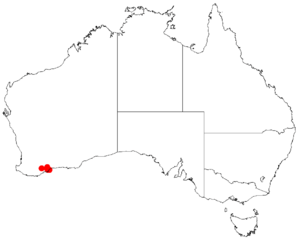Acacia simulans facts for kids
Quick facts for kids Acacia simulans |
|
|---|---|
| Conservation status | |
| Scientific classification | |
| Genus: |
Acacia
|
| Species: |
simulans
|
 |
|
| Occurrence data from AVH | |
Acacia simulans is a type of shrub. It belongs to the Acacia family, which is known for its many different species. This plant is special because it only grows in a specific part of southwestern Australia. This means it is "endemic" to that area.
What Does It Look Like?
The Acacia simulans shrub usually grows to be about 0.3 to 1 meter (1 to 3 feet) tall. It has branches that spread out. Its small branches are smooth or have very few hairs and are grey. They have tiny leaf-like parts called stipules, which are about 1 mm long.
Like most Acacia plants, it has special leaf-like structures called phyllodes instead of true leaves. These phyllodes are arranged in groups, with six to nine in each group. They are stiff, pointed, and smooth. They stick out or bend back slightly. Each phyllode is straight or slightly curved. They are about 8 to 15 mm long and 1 mm wide. They have four main veins.
This plant blooms from July to September. It produces yellow flowers. The flowers grow in simple groups, either alone or in pairs, where the leaves meet the stem. These flower-heads are round or slightly oval. Each one contains 16 to 20 cream to pale yellow flowers.
After the flowers, smooth, dark brown seed pods grow. They look a bit like a string of beads. These pods can be up to 7 cm long and 3 to 4 mm wide. Inside, the seeds are shiny and dark brown. They are shaped like a wide oval and are about 4 mm long. Each seed has a cone-shaped tip called an aril.
How It Was Named
The plant was first officially described by a botanist named Bruce Maslin in 1976. He wrote about it in a scientific journal called Nuytsia. Later, in 2003, another botanist, Leslie Pedley, reclassified it. But in 2006, it was moved back to the Acacia group.
Where It Grows
Acacia simulans grows in a small area of Western Australia. This area includes parts of the Great Southern and Goldfields-Esperance regions. You can find it from Jerramungup in the west to Ravensthorpe in the east.
It usually grows in sandy soils that are on top of a type of rock called quartzite. Its home is mainly within the Fitzgerald River National Park. Here, it is part of scrubland or heathland areas. These areas are often dominated by another plant called Eucalyptus tetraptera.


